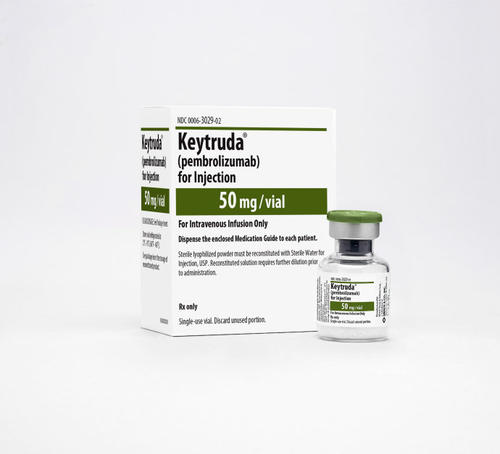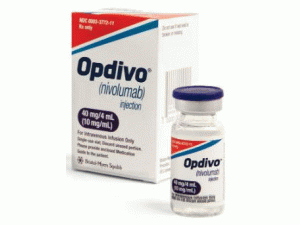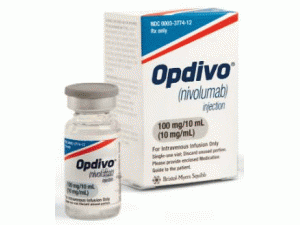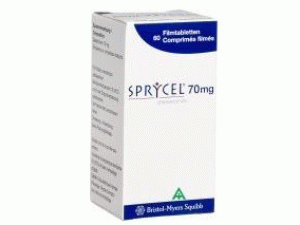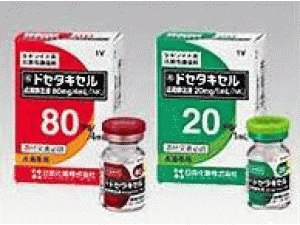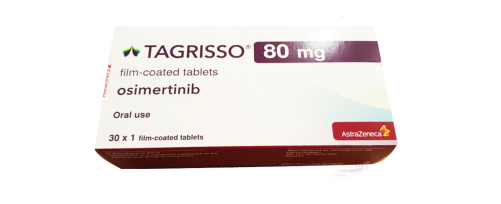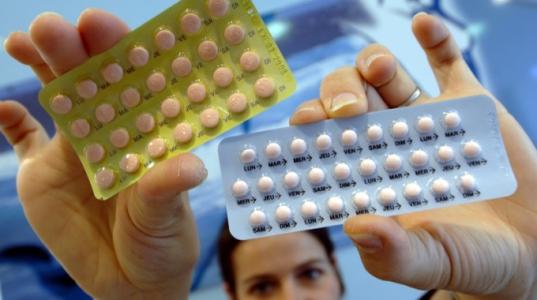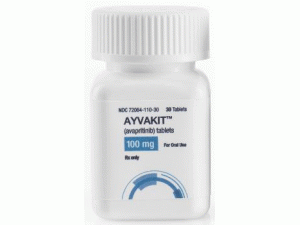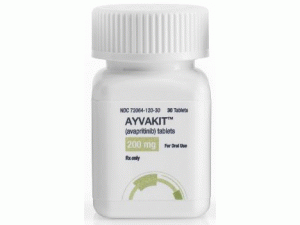紫杉醇注射用混悬液[白蛋白结合型](ABRAXANE Injectable Suspension)说明书
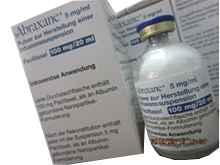 药店国别:无
药店国别:无
产地国家:德国
处方药:是
所属类别: 5mg/ml 100mg/20ml/Vial
包装规格: 5mg/ml 100mg/20ml/Vial
计价单位:盒
生产厂家中文参考译名:无
生产厂家英文名:Celgene
原产地英文商品名:ABRAXANE Injectable Suspension 5mg/ml 100mg/20ml/Vial
原产地英文药品名:paclitaxel protein-bound
中文参考商品译名:ABRAXANE注射用混悬液 5毫克/毫升 100毫克/20毫升/瓶
中文参考药品译名:紫杉醇白蛋白结合型
曾用名:无
简介:
2015年3月4日,生物技术巨头新基(Celgene)药物Abraxane(注射用紫杉醇[白蛋白结合型])在欧盟喜获新适应症——非小细胞肺癌(NSCLC)。欧盟委员会(EC)已批准Abraxane联合卡铂(carboplatin)用于不适合潜在可治愈性手术和/或放射治疗的非小细胞肺癌(NSCLC)成人患者的一线治疗。在欧盟,Abraxane已获批的其他适应症还包括:转移性胰腺癌和乳腺癌...
2012年10月12日,Celgene宣布美国食品药品管理局(FDA)已批准Abraxane(注射用白蛋白结合型紫杉醇悬液)与卡铂联用,作为不适宜接受根治性手术或放疗的局部晚期或转移性非小细胞肺癌(NSCLC)患者的一线治疗。 这一批准令标志着Abraxane在美国获得了第二种适应证。该药之前已于2005年获准用于治疗联合化疗失败的转移性乳腺癌。Abraxane的本次获准是基于一项3期、多中心、随机、开放标记研究的结果。在该研究中,晚期NSCLC患者接受Abraxane(100 mg/m2)/周+卡铂每3周1次(n=521),或紫杉醇(200 mg/m2)每3周1次+卡铂(n=531)治疗。这项研究达到了其主要终点,表明Abraxane组患者的总应答率显著高于紫杉醇组(33% vs. 25%)。与Abraxane联合卡铂治疗NSCLC有关的最常见不良反应包括,贫血、中性粒细胞减少、血小板减少、脱发、周围神经病变、恶心和疲乏。 在Abraxane+卡铂治疗组和紫杉醇+卡铂治疗组患者中发生率相似的不良反应包括:脱发56%,恶心27%,疲乏25%,食欲不振17%,无力16%,便秘16%,腹泻15%,呕吐12%,呼吸困难12%,以及皮疹10%(以上均为Abraxane+卡铂治疗组的发生率)。英文版说明:
abraxane (Paclitaxel) injection, powder, lyophilized, for suspension[Abraxis BioScience, LLC.]ABRAXANE is indicated for the treatment of breast cancer after failure of combination chemotherapy for metastatic disease or relapse within 6 months of adjuvant chemotherapy. Prior therapy should have included an anthracycline unless clinically contraindicated.ABRAXANE is indicated for the first-line treatment of locally advanced or metastatic non–small cell lung cancer, in combination with carboplatin, in patients who are not candidates for curative surgery or radiation therapy.ABRAXANE is indicated for the first-line treatment of patients with metastatic adenocarcinoma of the pancreas, in combination with gemcitabine.IMPORTANT SAFETY INFORMATIONWARNING – NEUTROPENIADo not administer ABRAXANE therapy to patients who have baseline neutrophil counts of less than 1500 cells/mm3. In order to monitor the occurrence of bone marrow suppression, primarily neutropenia, which may be severe and result in infection, it is recommended that frequent peripheral blood cell counts be performed on all patients receiving ABRAXANENote: An albumin form of paclitaxel may substantially affect a drug’s functional properties relative to those of drug in solution. DO NOT SUBSTITUTE FOR OR WITH OTHER PACLITAXEL FORMULATIONSCONTRAINDICATIONSNeutrophil CountsABRAXANE should not be used in patients who have baseline neutrophil counts of <1500 cells/mm3HypersensitivityPatients who experience a severe hypersensitivity reaction to ABRAXANE should not be rechallenged with the drugWARNINGS AND PRECAUTIONSHematologic EffectsBone marrow suppression (primarily neutropenia) is dose-dependent and a dose-limiting toxicity of ABRAXANE. In clinical studies, Grade 3-4 neutropenia occurred in 34% of patients with metastatic breast cancer (MBC), 47% of patients with non–small cell lung cancer (NSCLC), and 38% of patients with pancreatic cancerMonitor for myelotoxicity by performing complete blood cell counts frequently, including prior to dosing on Day 1(for MBC) and Days 1, 8, and 15 (for NSCLC and for pancreatic cancer)Do not administer ABRAXANE to patients with baseline absolute neutrophil counts (ANC) of less than 1500 cells/mm3In the case of severe neutropenia (<500 cells/mm3 for 7 days or more) during a course of ABRAXANE therapy, reduce the dose of ABRAXANE in subsequent courses in patients with either MBC or NSCLCIn patients with MBC, resume treatment with every-3-week cycles of ABRAXANE after ANC recovers to a level >1500 cells/mm3 and platelets recover to a level >100,000 cells/mm3In patients with NSCLC, resume treatment if recommended at permanently reduced doses for both weekly ABRAXANE and every-3-week carboplatin after ANC recovers to at least 1500 cells/mm3 and platelet count of at least 100,000 cells/mm3 on Day 1 or to an ANC of at least 500 cells/mm3 and platelet count of at least 50,000 cells/mm3 on Days 8 or 15 of the cycleIn patients with adenocarcinoma of the pancreas, withhold ABRAXANE and gemcitabine if the ANC is less than 500 cells/mm3 or platelets are less than 50,000 cells/mm3 and delay initiation of the next cycle if the ANC is less than 1500 cells/mm3 or platelet count is less than 100,000 cells/mm3 on Day 1 of the cycle. Resume treatment with appropriate dose reduction if recommendedNervous SystemSensory neuropathy is dose- and schedule-dependentThe occurrence of Grade 1 or 2 sensory neuropathy does not generally require dose modificationIf ≥ Grade 3 sensory neuropathy develops, withhold ABRAXANE treatment until resolution to Grade 1 or 2 for MBC or until resolution to ≤ Grade 1 for NSCLC and pancreatic cancer followed by a dose reduction for all subsequent courses of ABRAXANESepsisSepsis occurred in 5% of patients with or without neutropenia who received ABRAXANE in combination with gemcitabineBiliary obstruction or presence of biliary stent were risk factors for severe or fatal sepsisIf a patient becomes febrile (regardless of ANC), initiate treatment with broad-spectrum antibioticsFor febrile neutropenia, interrupt ABRAXANE and gemcitabine until fever resolves and ANC ≥1500 cells/mm3, then resume treatment at reduced dose levelsPneumonitisPneumonitis, including some cases that were fatal, occurred in 4% of patients receiving ABRAXANE in combination with gemcitabineMonitor patients for signs and symptoms and interrupt ABRAXANE and gemcitabine during eva luation of suspected pneumonitisPermanently discontinue treatment with ABRAXANE and gemcitabine upon making a diagnosis of pneumonitisHypersensitivitySevere and sometimes fatal hypersensitivity reactions, including anaphylactic reactions, have been reportedPatients who experience a severe hypersensitivity reaction to ABRAXANE should not be rechallenged with this drugHepatic ImpairmentBecause the exposure and toxicity of paclitaxel can be increased with hepatic impairment, administration of ABRAXANE in patients with hepatic impairment should be performed with cautionPatients with hepatic impairment may be at an increased risk of toxicity, particularly from myelosuppression, and should be monitored for development of profound myelosuppressionFor MBC and NSCLC, the starting dose should be reduced for patients with moderate or severe hepatic impairmentFor pancreatic adenocarcinoma, ABRAXANE is not recommended for patients with moderate to severe hepatic impairment (total bilirubin >1.5 x ULN and AST ≤10 x ULN)Albumin (Human)ABRAXANE contains albumin (human), a derivative of human bloodUse in Pregnancy: Pregnancy Category DABRAXANE can cause fetal harm when administered to a pregnant womanIf this drug is used during pregnancy, or if the patient becomes pregnant while receiving this drug, the patient should be apprised of the potential hazard to the fetusWomen of childbearing potential should be advised to avoid becoming pregnant while receiving ABRAXANEUse in MenMen should be advised not to father a child while receiving ABRAXANEADVERSE REACTIONSRandomized Metastatic Breast Cancer (MBC) StudyThe most common adverse reactions (≥20%) with single-agent use of ABRAXANE vs paclitaxel injection in the MBC study are alopecia (90%, 94%), neutropenia (all cases 80%, 82%; severe 9%, 22%), sensory neuropathy (any symptoms 71%, 56%; severe 10%, 2%), abnormal ECG (all patients 60%, 52%; patients with normal baseline 35%, 30%), fatigue/asthenia (any 47%, 39%; severe 8%, 3%), myalgia/arthralgia (any 44%, 49%; severe 8%, 4%), AST elevation (any 39%, 32%), alkaline phosphatase elevation (any 36%, 31%), anemia (any 33%, 25%; severe 1%, <1%), nausea (any 30%, 22%; severe 3%, <1%), diarrhea (any 27%, 15%; severe <1%, 1%) and infections (24%, 20%), respectivelySensory neuropathy was the cause of ABRAXANE discontinuation in 7/229 (3%) patientsOther adverse reactions of note with the use of ABRAXANE vs paclitaxel injection included vomiting (any 18%, 10%; severe 4%, 1%), fluid retention (any 10%, 8%; severe 0%, <1%), mucositis (any 7%, 6%; severe <1%, 0%), hepatic dysfunction (elevations in bilirubin 7%, 7%), hypersensitivity reactions (any 4%, 12%; severe 0%, 2%), thrombocytopenia (any 2%, 3%; severe <1%, <1%), neutropenic sepsis (<1%, <1%), and injection site reactions (<1%, 1%), respectively. Dehydration and pyrexia were also reportedRenal dysfunction (any 11%, severe 1%) was reported in patients treated with ABRAXANE (n=229)In all ABRAXANE-treated patients (n=366), ocular/visual disturbances were reported (any 13%; severe 1%)Severe cardiovascular events possibly related to single-agent ABRAXANE occurred in approximately 3% of patients and included cardiac ischemia/infarction, chest pain, cardiac arrest, supraventricular tachycardia, edema, thrombosis, pulmonary thromboembolism, pulmonary emboli, and hypertensionCases of cerebrovascular attacks (strokes) and transient ischemic attacks have been reportedNon–Small Cell Lung Cancer (NSCLC) StudyThe most common adverse reactions (≥20%) of ABRAXANE in combination with carboplatin are anemia, neutropenia, thrombocytopenia, alopecia, peripheral neuropathy, nausea, and fatigueThe most common serious adverse reactions of ABRAXANE in combination with carboplatin for NSCLC are anemia (4%) and pneumonia (3%)The most common adverse reactions resulting in permanent discontinuation of ABRAXANE are neutropenia (3%), thrombocytopenia (3%), and peripheral neuropathy (1%)The most common adverse reactions resulting in dose reduction of ABRAXANE are neutropenia (24%), thrombocytopenia (13%), and anemia (6%)The most common adverse reactions leading to withholding or delay in ABRAXANE dosing are neutropenia (41%), thrombocytopenia (30%), and anemia (16%)The following common (≥10% incidence) adverse reactions were observed at a similar incidence in ABRAXANE plus carboplatin–treated and paclitaxel injection plus carboplatin–treated patients: alopecia (56%), nausea (27%), fatigue (25%), decreased appetite (17%), asthenia (16%), constipation (16%), diarrhea (15%), vomiting (12%), dyspnea (12%), and rash (10%); incidence rates are for the ABRAXANE plus carboplatin treatment groupAdverse reactions with a difference of ≥2%, Grade 3 or higher, with combination use of ABRAXANE and carboplatin vs combination use of paclitaxel injection and carboplatin in NSCLC are anemia (28%, 7%), neutropenia (47%, 58%), thrombocytopenia (18%, 9%), and peripheral neuropathy (3%, 12%), respectivelyAdverse reactions with a difference of ≥5%, Grades 1-4, with combination use of ABRAXANE and carboplatin vs combination use of paclitaxel injection and carboplatin in NSCLC are anemia (98%, 91%), thrombocytopenia (68%, 55%), peripheral neuropathy (48%, 64%), edema peripheral (10%, 4%), epistaxis (7%, 2%), arthralgia (13%, 25%), and myalgia (10%, 19%), respectivelyNeutropenia (all grades) was reported in 85% of patients who received ABRAXANE and carboplatin vs 83% of patients who received paclitaxel injection and carboplatinPancreatic Adenocarcinoma StudyAmong the most common (≥20%) adverse reactions in the phase III study, those with a ≥5% higher incidence in the ABRAXANE/gemcitabine group compared with the gemcitabine group are neutropenia (73%, 58%), fatigue (59%, 46%), peripheral neuropathy (54%, 13%), nausea (54%, 48%), alopecia (50%, 5%), peripheral edema (46%, 30%), diarrhea (44%, 24%), pyrexia (41%, 28%), vomiting (36%, 28%), decreased appetite (36%, 26%), rash (30%, 11%), and dehydration (21%, 11%)Of these most common adverse reactions, those with a ≥2% higher incidence of Grade 3-4 toxicity in the ABRAXANE/gemcitabine group compared with the gemcitabine group, respectively, are neutropenia (38%, 27%), fatigue (18%, 9%), peripheral neuropathy (17%, 1%), nausea (6%, 3%), diarrhea (6%, 1%), pyrexia (3%, 1%), vomiting (6%, 4%), decreased appetite (5%, 2%), and dehydration (7%, 2%)Thrombocytopenia (all grades) was reported in 74% of patients in the ABRAXANE/gemcitabine group vs 70% of patients in the gemcitabine groupThe most common serious adverse reactions of ABRAXANE (with a ≥1% higher incidence) are pyrexia (6%), dehydration (5%), pneumonia (4%), and vomiting (4%)The most common adverse reactions resulting in permanent discontinuation of ABRAXANE were peripheral neuropathy (8%), fatigue (4%), and thrombocytopenia (2%)The most common adverse reactions resulting in dose reduction of ABRAXANE are neutropenia (10%) and peripheral neuropathy (6%)The most common adverse reactions leading to withholding or delay in ABRAXANE dosing are neutropenia (16%), thrombocytopenia (12%), fatigue (8%), peripheral neuropathy (15%), anemia (5%), and diarrhea (5%)Other selected adverse reactions with a ≥5% higher incidence for all-grade toxicity in the ABRAXANE/gemcitabine group compared to the gemcitabine group, respectively, are asthenia (19%, 13%), mucositis (10%, 4%), dysgeusia (16%, 8%), headache (14%, 9%), hypokalemia (12%, 7%), cough (17%, 7%), epistaxis (15%, 3%), urinary tract infection (11%, 5%), pain in extremity (11%, 6%), arthralgia (11%, 3%), myalgia (10%, 4%), and depression (12%, 6%)Other selected adverse reactions with a ≥2% higher incidence for Grade 3-4 toxicity in the ABRAXANE/gemcitabine group compared to the gemcitabine group are thrombocytopenia (13%, 9%), asthenia (7%, 4%), and hypokalemia (4%, 1%)Postmarketing Experience With ABRAXANE and Other Paclitaxel FormulationsSevere and sometimes fatal hypersensitivity reactions have been reported with ABRAXANE. The use of ABRAXANE in patients previously exhibiting hypersensitivity to paclitaxel injection or human albumin has not been studiedThere have been reports of congestive heart failure, left ventricular dysfunction, and atrioventricular block with ABRAXANE, primarily among individuals with underlying cardiac history or prior exposure to cardiotoxic drugsThere have been reports of extravasation of ABRAXANE. Given the possibility of extravasation, it is advisable to monitor closely the ABRAXANE infusion site for possible infiltration during drug administrationDRUG INTERACTIONSCaution should be exercised when administering ABRAXANE concomitantly with medicines known to inhibit or induce either CYP2C8 or CYP3A4USE IN SPECIFIC POPULATIONSNursing MothersIt is not known whether paclitaxel is excreted in human milk. Because many drugs are excreted in human milk and because of the potential for serious adverse reactions in nursing infants, a decision should be made to discontinue nursing or to discontinue the drug, taking into account the importance of the drug to the motherPediatricThe safety and effectiveness of ABRAXANE in pediatric patients have not been eva luatedGeriatricA higher incidence of epistaxis, diarrhea, dehydration, fatigue, and peripheral edema was found in patients 65 years or older who received ABRAXANE for MBC in a pooled analysis of clinical studiesMyelosuppression, peripheral neuropathy, and arthralgia were more frequent in patients ≥65 years of age treated with ABRAXANE and carboplatin in NSCLCDiarrhea, decreased appetite, dehydration, and epistaxis were more frequent in patients 65 years or older compared with patients younger than 65 years old who received ABRAXANE and gemcitabine in adenocarcinoma of the pancreasRenal ImpairmentThere are insufficient data to permit dosage recommendations in patients with severe renal impairment or end stage renal disease (estimated creatinine clearance <30 mL/min)DOSAGE AND ADMINISTRATIONDo not administer ABRAXANE to any patient with total bilirubin greater than 5 x ULN or AST greater than 10 x ULNFor MBC and NSCLC, reduce starting dose in patients with moderate to severe hepatic impairmentFor adenocarcinoma of the pancreas, do not administer ABRAXANE to patients who have moderate to severe hepatic impairmentDose reductions or discontinuation may be needed based on severe hematologic, neurologic, cutaneous, or gastrointestinal toxicityMonitor patients closely.
药品价格查询,专业药品查询网站,药品说明书查询,药品比价 » 紫杉醇注射用混悬液[白蛋白结合型](ABRAXANE Injectable Suspension)说明书
说明书](/uploads/202210/16/221016013638235.png)
